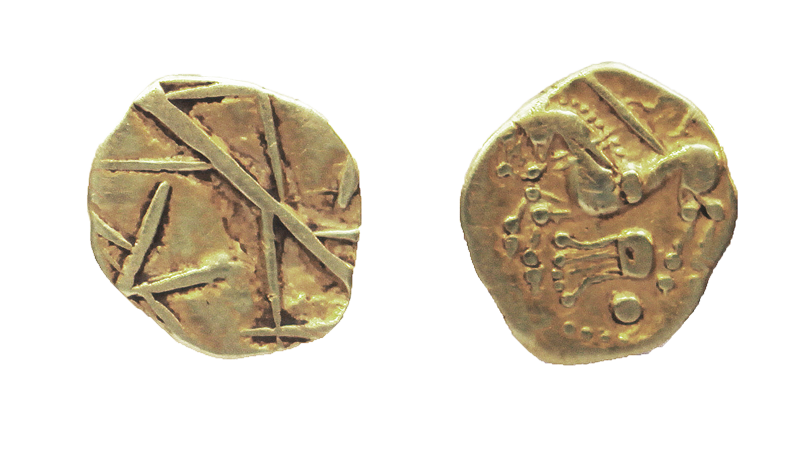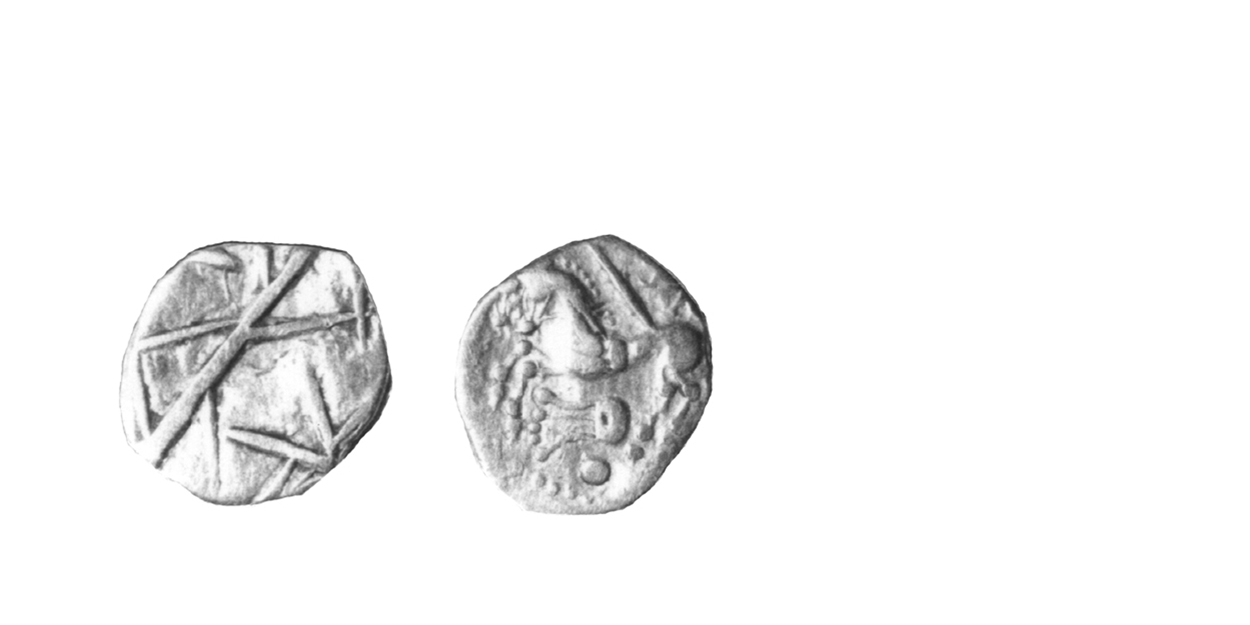
History
Imported Coinages – Introduction (Info)
The Period of Imported Coinage 125–100 BC.
Ancient Britain was far from isolated from the rest of Europe. The British tribes had active contact with the Celtic peoples on the Continent and a lively commodities trade was carried on cross-Channel. As early as the late Bronze Age, about 1000 BC., finished metal objects and also scrap metal for local manufacturing were imported into Britain (3). This trade continued into the Iron Age, mirroring the use of metals on the Continent. As iron first began to replace bronze for high-prestige goods in Gaul, the same replacement occurred in Britain. As the use of iron became common in Gaul, it became widely used in Britain as well. The British tribes, rather than being isolated, appear to have been well-connected with those on the Continent.
By the Second Century BC., the growing trade in commodities between Britain and the Continent became more intense (4). Wine, prestige metal goods and exotic plants and animals were all imported in exchange for British raw metals and other commodities. The British tribes also supplied manpower to the Gallic tribes in the form of mercenary warriors or slaves for the Roman slave trade. The cross-Channel trade eventually expanded until coinage was needed to facilitate negotiations. At this point, coins already in use on the Continent, began to flow from Gaul to the British tribes. They were brought to Britain in several ways: some were used in actual trading transactions, others were brought back as pay by returning mercenaries, and yet others may have been carried over by raiding-parties or settlers from the Continent. Gifts between tribal leaders could account for the appearance of others. There is some debate as to the date of the first importations, but 125 BC. is a reasonable estimate.
There were two trade routes, the most important of which supplied the Roman economy. The Roman world was in perennial need of raw materials, particularly tin and iron, and was especially dependent on slave labour. Both commodities had to be obtained outside the empire because domestic sources were inadequate to satisfy Roman needs. Britain, significantly, had both manpower and metals in abundance (5).
The Romans occupied Southern Gaul in 125 BC., and used this as a base for trade. They encouraged the taste for wine amongst the Celtic tribes, an addiction that created a market for an abundant Roman product. The Romans then traded cheap wine for expensive tin, iron and slaves at a four hundred percent profit. Although this trade was conducted by private Roman merchants, it is known the Roman government encouraged it. Initially, the Romans traded with local Celtic tribes around Massalia who, in turn, traded with other tribes up the Rhone. These intermediates then sent the wine down the Garonne, where it was placed on Venetic ships, which traveled by ocean to the Armorican peninsula (Brittany, today), whence it was re-exported to Southern Britain. St. Malo, on the north coast of Brittany, and the British ports of Mount Batten, Hengistbury, and a possibly submerged one at Selsey were active trading partners. Shards of thirty Roman wine amphorae have been found at Hengistbury, dating to the early First Century, and Armorican coins have been found throughout the south coast of Britain. Finds of similar amphorae in Armorica attest to the trade route and the commodity traded.
In the beginning, it is likely the Romans had no idea of the origin of the goods they received, and the Celtic intermediaries tried to retain the secret. The information could not be concealed indefinitely, however, and the Romans soon learned about the British trade. Ultimately, they tired of the long chain of distribution, and sought direct contact. Strabo gives an account of a Roman war galley sent to follow Phoenician trading ships to discover the British trade route. Rome's desire for direct trade was one of the motives for the Claudian invasion many years later.
A second trade route is also known, cross-Channel from the Belgic part of Gaul (northern France and Belgium, today) to Kent and the mouth of the Thames. Whether the Romans instigated this trade is unknown, but it occurred at the same time as the Armorican wine trade. Gaulish coins of the Ambiani tribe, dated to 125-100 BC., are found in great numbers throughout southeast Britain today (6).
In the past, the existence of Gaulish coins in Britain was taken as sign of a series of invasions from the Continent. Certain tribes, such as the Atrebates, Parisii, and possibly the Iceni had groups on both sides of the Channel. The movement of coins from the Continent to Britain, in the case of these tribes, could have indicated the movement of people as well as goods but these groups were not the ones involved. Furthermore, there is no archaeological evidence of the wide-scale disruption such invasions would have caused. Coin imports are believed today to give testimony to trade, not military activity (7).
The situation existing about 100 BC., a quarter of a century after the first coin imports, is one in which the tribes of the Armorican peninsula were trading with the British southern coast, and the Belgic tribes were trading with Kent and tribes around the mouth of the Thames. A lively cross-trade along the British coast from the southwest to the Thames area is a probability. Coastal trading would explain why small numbers of Armorican coins are found in Kent, around the Thames and in Essex; and why Ambiani coins are found similarly along the coast of Dorset, Devon and Cornwall.
Next section: Imported Coinages – First Imported Coins

